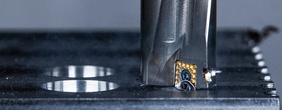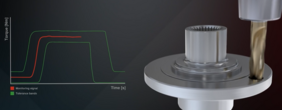The drilling processes covered by the SmartDrilling research project account for a significant proportion of the operations used in the machining of metal components. Ever-increasing demands in terms of quality and cost efficiency, as well as a growing shortage of personnel, are forcing the metalworking industry to increasingly automate its manufacturing processes. Machine tools available today enable the automated guidance of rotating tools for machining metallic workpieces before the start of machining the defined paths. Although this part of production runs automatically, the supervision of a human operator is still required to ensure a safe and productive process flow, as the tools used blunt at an unpredictable speed, form chipping on their cutting edges or even break off completely. If this tool damage goes unnoticed, the consequences are significantly reduced productivity and surface quality, as well as serious damage due to excessive forces and bending moments on the tool and the drilling spindle, or collisions between the spindle and the workpiece.
The SmartDrilling project pursued the vision of efficient drilling processes that do not require the constant attention of a machine operator. The prerequisite for this is a significant further development in the exchange of information between man and machine tool. The aim was to develop a "Tool Condition Monitoring System" that is capable of displaying the damage status of drilling tools during their use, i.e. even while the drill is turning in the hole being drilled. The basis for this should be sensor signals that the machine tool records in order to be able to precisely execute the movements of the drill specified by the operator. These sensor signals are now segmented using the specially developed software-based data processing technology so that the analysis can be limited to the parts of the signals relevant to the tool status. The developed data analysis algorithm continuously provides information on the current status of the tool damage, which is constantly updated on a display during the drilling process. An audible alarm sounds shortly before the drilling tool reaches a critical state of damage, enabling the process-safe operation of several machine tools by a single person. This enables the operator to optimize the management of the time sequences for manual intervention, machine loading and maintenance.
Impact and effects
The tool condition monitoring system implemented in SmartDrilling is a milestone in terms of increasing the efficiency of metal-cutting component production. The cost advantages generated for manufacturing companies through the use of the developed tool condition monitoring system will make a decisive contribution to maintaining the competitiveness of domestic industrial operations. The SmartDrilling project thus contributes to safeguarding Austria as a production location, domestic jobs and therefore also social security systems.
In addition to the expected economic benefits, major environmental savings can also be expected as drills are reground in good time and workpiece scrap is avoided.
–
Project coordination (Story)
Dr Thomas Klünsner
Group Leader Hard Metals
Materials Center Leoben Forschung GmbH
T +43 (0) 3842 45922-33
thomas.kluensner(at)mcl.at
IC-MPPE / COMET-Zentrum
Materials Center Leoben Forschung GmbH
Roseggerstrasse 12
8700 Leoben
T +43 (0) 3842 45922-0
mclburo(at)mcl.at
www.mcl.at
Project partners
• Ceratizit Austria GmbH, Österreich
• KNOW-Center GmbH, Österreich
• Materials Center Leoben Forschung GmbH, Österreich




















